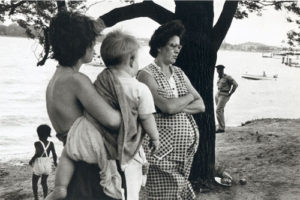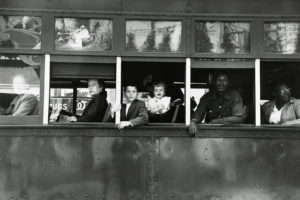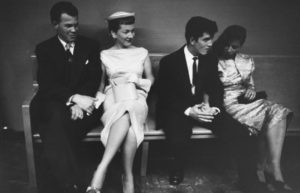
The now-popular habit of celebrating 50th anniversaries of cultural events has us currently revisiting the late 1950’s. We marked a half-century since the publication of Jack Kerouac’s “On the Road” (1957). At the beginning of the decade, it was J.D. Salinger’s “The Catcher in the Rye” (1951).
Now, it’s photographer Robert Frank’s landmark book, “The Americans” (1959). All three challenged the prevailing zeitgeist, which was that America, having emerged from World War II as a military and economic superpower with a rising middle class, was a pretty good place to be in the ‘50s. These artists uncovered something different – harsh inequalities and a feeling of loneliness and disconnection in the middle of the party.
Kerouac, who wrote the introduction to Frank’s book, was the most lyrical. He felt the sadness of America’s open highways and nothing street corners, but he also pulsed with its manic energies.
Frank, whose 83-photo essay on America in the ‘50s is spread out on the walls of the Metropolitan Museum (along with earlier work, contact sheets, letters and other memorabilia), was a different story. Unlike the Massachusetts-born Kerouac, he was Swiss and Jewish – an outsider (whose otherness did not go unnoticed by police in the South) — and, though he crisscrossed the 48 states in a car, was not at all enamored of life on the road.

His America was an often-shallow materialistic society that didn’t want to confront social inequities and racism. The front cover of his book shows a New Orleans trolley car. It takes you a moment to notice that the faces framed in the front three windows are white and those in the back two are black. He could easily have chosen a more obvious illustration of southern segregation – say, a lunch counter with a “white’s only” sign — as other photographers did,
That wasn’t Frank’s style, which is part of what gives his photographs their poetry. The book’s first photo, titled “Parade – Hoboken, New Jersey, 1955,” has no parade. Instead you see two women looking out their windows; one’s face is in shadow, the other is obscured by the billowing flag attached to the brick façade — not how Life magazine would have photographed that festive event. On the next page, you see the dour, pompous top-hatted politicians on the reviewing stand, but still no parade. Nor do you see what the elegant black man with the sharp cheekbones is looking at, though you’re told it’s a funeral in St. Helena, South Carolina.
Frank often made bit players the focus of his pictures: the elevator girl in the Miami hotel, the old man on the bench at the Yale commencement, the counter girl at the railroad station luncheonette. He blurred the face of a Hollywood starlet to better focus on the ordinary women who stare at her.
Frank cast a jaundiced eye at the car culture. A photo of a long car draped with a dust cover is juxtaposed with one of a similarly covered accident victim. Young lovers in Ann Arbor, Michigan stretch out on blankets only a few feet from the open doors of their parked autos. The picture of the New Mexico highway, its white lines racing to the horizon, captures some of the romance that lured Kerouac, but its dark close-to-the-asphalt view is more monotonous and claustrophobic.

Frank spent a year putting the book together, an extremely long time for a photographer to mull over selection and sequences. Seeing the book’s photos up on gallery walls gives you a wider perspective on why pictures are in certain orders. The connections are sometimes obvious (a black preacher kneeling by the Mississippi and a statue of St. Francis with a similar profile) and sometimes tricky (after several photos with star shapes in them, he puts one of a starlet).
“The Americans” came under harsh criticism when it was published. Photography critics decried its off-kilter, sometimes blurry, over-the-shoulder style. Others took it to task for a negative and dismal outlook. A lot has changed in America since Frank took these pictures. A once-segregated country has elected a black man as its president. Our zeitgeist routinely condescends to the zeitgeist of 1950s America, which means that the iconoclastic Franks is very mainstream, now. To make the kind of fuss he once did, he’d have to put together a version showing what an often happy place America was back in those days.

